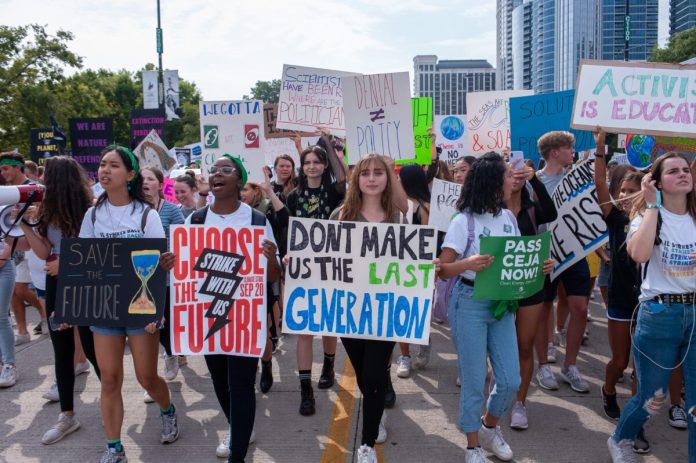The idea of a green recovery from the COVID-19 pandemic is gaining traction around the world. The UK recently pledged to invest £350 million to cut emissions from heavy industry. South Korea promised to create 1.9 million jobs by developing green technologies. China presented a plan to become carbon neutral before 2060.
And, on September 16, European Commission president, Ursula von der Leyen, promoted the EU Green Deal as the bloc’s strategy for reviving economic activity. In her speech, she pledged to cut at least 55% of the EU’s total emissions by 2030 – a goal that the European parliament later increased to 60%.
World leaders have rightly seized on the pandemic as a chance to build more sustainable economies, whether it’s boosting investment in green energy or curbing unemployment by announcing new jobs retrofitting housing. What’s missing though, are the loud and inconvenient voices from the streets.
Fridays for Future started as a lone protest outside the Swedish parliament by Greta Thunberg in August 2018, but it has quickly grown into a global movement. The pandemic forced the school climate strikes to move online, largely shifting the burgeoning youth movement from the public eye. Yet, the vibrant protests that catapulted climate change to the political fore are actually needed now more than ever.
Expanding the debate
Many of the green recovery plans proposed by governments so far include investments in renewable energy, or measures to modernise polluting industries such as steel or cement production. For example, the EU announced a €1 billion innovation fund in July 2020 to finance breakthrough technologies in renewable energy, energy storage, or carbon capture.
But our research shows that many young climate activists are critical of reviving growth, only a little greener, while leaving existing political and economic structures intact. In Germany, youth climate groups have led calls to bring electricity utilities under the ownership of local communities. They argue that switching to renewables should involve redistributing the power held by energy corporations, rather than simply boosting how much green energy they generate.
Read more: Five ways to kickstart a green recovery
These demands weren’t inevitable at the movement’s outset. Many of these arguments about who should own and lead the green transition were fomented in August 2019, when climate strikers met for a summer congress in Germany. Here, they discussed alternatives to decarbonising society through green economic growth, such as redefining development itself so that growth isn’t the goal. One month later, Thunberg criticised world leaders for providing “fairy tales of eternal economic growth” at the UN Climate Action Summit in New York.
Making these arguments heard is essential for a lively debate about recovery plans that will shape all of our futures. An active youth movement can shift the debate from the terrain of immediate economic benefits, to questions of equity and ownership which current green recovery debates mostly lack.
An inconvenient youth
It can also amplify the voices of people most vulnerable to the enfolding climate crisis. In her first speech at a UN climate change conference in December 2018, Thunberg spoke on behalf of Climate Justice Now, a transnational network representing indigenous people, communities of colour and low-income families – people who are disproportionally affected by climate change.
In July 2020, Fridays for Future activists published an open letter to world leaders urging them to reckon with the deep injustices at the core of the climate crisis. Those least responsible for climate change, they argue, are most affected by its consequences.
Following protests on September 25 – the first since the pandemic began – Thunberg criticised the EU for “cheating with numbers” in its pledge to cut emissions by two-thirds in ten years. The target, she explained, does not account for international aviation, shipping, or goods consumed in the EU but manufactured abroad. She said:
There can be no social justice without climate justice. And there can be no climate justice unless we acknowledge the fact that we have dumped large parts of our emissions overseas, exploiting cheap labour and poor working conditions as well as weaker environmental regulations.
The stubbornness of youth climate activists can help raise the ambition of governments devising economic recoveries from COVID-19, and ensure they address the needs of the most vulnerable. Coronavirus might constrain outdoor organising, but the climate movement’s influence remains vital for widening the debate about the kind of world that emerges from the pandemic.
Jens Marquardt, Postdoctoral Researcher in Environmental Social Science, Stockholm University
This article is republished from The Conversation under a Creative Commons license. Read the original article.
Related posts:
Views: 0
 RSS Feed
RSS Feed
















 October 22nd, 2020
October 22nd, 2020  Awake Goy
Awake Goy 

 Posted in
Posted in  Tags:
Tags: 
















